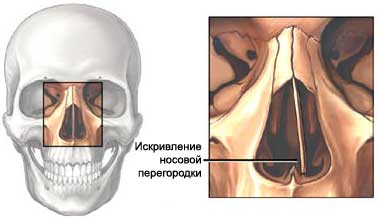Septoplasty – Septoplasty
Description septoplasty
Septoplasty – surgery to correct curvature of the nasal septum. A partition separates the left and right sides of the nasal cavity. It consists of a cartilage and bone, and is lined with a thin mucosa.
A normal septum divides the nose into two equal symmetrical parts. When a deviated septum is bent or significantly deviates from the central position. Septum deviation may occur during development in the womb, during birth or after injury. Septoplasty may be performed in conjunction with other nasal surgery, such as Rhinoplasty.
Reasons for septoplasty
Septoplasty is performed, if a deviated septum closes the nasal passages. The obstruction can cause impaired nasal breathing, infection of the sinuses, Obstructive Sleep Apnea, recurrent nose bleeds, or the common cold. Septoplasty septum may be necessary, If the curvature causes chronic headaches.

Possible complications septoplasty
Complications are rare, but the procedure does not guarantee the absence of risk. If you plan to septoplasty, you need to know about possible complications, which may include:
- Numbness in the tip of the nose or upper front teeth;
- Bleeding;
- Infection;
- Septalynaya perforation (hole in the septum);
- The lack of improvement in symptoms;
- Unsatisfactory cosmetic outcome.
Some factors, that may increase the risk of complications:
- Smoking;
- Blood clotting;
- Health problems, such as heart disease;
- Cocaine use;
- Prior nose surgery with excessive scarring;
- Taking certain medications.
How is septoplasty?
Preparation for the procedure
To prepare for surgery, Follow your doctor's instructions.
- Tell your doctor about taking any medications. A week before surgery you may be asked to stop taking certain drugs:
- Aspirin or other anti-inflammatory drugs;
- Blood thinners, such as clopidogrel (Plaviks) or warfarin;
- If local anesthesia is used, quite possibly, no other preparation is required. If you plan general anesthesia, the doctor will give you further instructions.
Anesthesia
Septoplasty can be done under local or general anesthesia. Local anesthesia numb the area operation. General anesthesia blocks pain and the patient support in a sleep state during operation.
Procedure septoplasty
The nose will make the cut. Cover walls will be removed. Curved bone or cartilage will be straightened, moved or deleted. After correcting the defect of the nasal cover is placed on the place. The nose pads can be placed, to soak up the blood of the stand-out. It may additionally be installed plastic splints, to retain the shape of the partition to healing.
How long will septoplasty?
About 1-1,5 hours.
Septoplasty – Will it hurt?
Anesthesia will minimize pain during surgery. After the operation, the nose may be sensitive or slightly painful. To remove the pain after the procedure, the doctor provides pain medicine.
The average hospital stay
Most patients can go home after 3-4 hours after septoplasty.
Keeping the postoperative period after septoplasty
If you are using nasal swabs, they are removed through 1-2 day after surgery. The tire remains in the nose for one week. To ensure proper recovery, follow these guidelines:
- Try to breathe through the mouth for a few days after surgery;
- You can not blow your nose;
- First 1-2 days after septoplasty, lying in bed, keep your head elevated;
- Applying ice to the nose will reduce the pain and swelling;
- Do not take painkillers, aspirin;
- Visit the doctor to monitor the recovery or removal of nasal swabs or bus;
- Be sure to follow your doctor's instructions.
Contact your doctor after septoplasty
After discharge from the hospital need to see a doctor, If the following symptoms:
- Signs of infection, including fever and chills;
- Redness, edema, strong pain, bleeding or discharge from the incision;
- Heavy bleeding;
- Swab of nose falls into the area of the throat, causing discomfort;
- Nausea and / or vomiting, which do not disappear after taking the prescribed medicines and persist for more than two days after discharge from the hospital;
- Pain, which does not pass after taking pain medication appointed;
- Cough, shortness of breath or chest pain.
